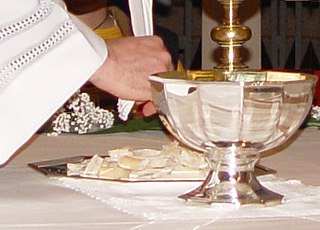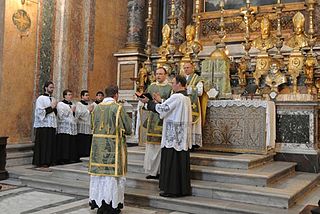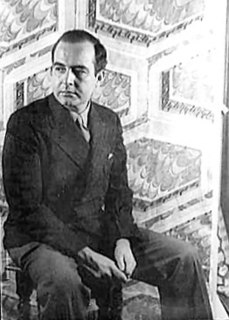
Agnus Dei is the Latin name under which the "Lamb of God" is honoured within the Roman Catholic Mass and, by extension, other Christian liturgies descending from the Latin tradition. It is the name given to a specific prayer that occurs in these liturgies, and is the name given to the music pieces that accompany the text of this prayer.

Mass is the main Eucharistic liturgical service in many forms of Western Christianity. The term Mass is commonly used in the Catholic Church, and in the Western Rite Orthodox, and Old Catholic churches. The term is used in some Lutheran churches, as well as in some Anglican churches. It is rarely, if ever, used by other Protestant churches, such as in Methodism.

Lamb of God is a title for Jesus that appears in the Gospel of John. It appears at John 1:29, where John the Baptist sees Jesus and exclaims, "Behold the Lamb of God who takes away the sin of the world." It appears again in John 1:36.
A Dialogue Mass is a Low Mass in which the people recite some parts of the Latin Tridentine Mass.
The ordinary, in Roman Catholic and other Western Christian liturgies, refers to the part of the Eucharist or of the canonical hours that is reasonably constant without regard to the date on which the service is performed. It is contrasted to the proper, which is that part of these liturgies that varies according to the date, either representing an observance within the liturgical year, or of a particular saint or significant event, or to the common which contains those parts that are common to an entire category of saints such as apostles or martyrs.

Solemn Mass is the full ceremonial form of the Tridentine Mass, celebrated by a priest with a deacon and a subdeacon, requiring most of the parts of the Mass to be sung, and the use of incense. It is also called High Mass or Solemn High Mass. However, in the United States the term "High Mass" is also used to describe the less elaborate Missa Cantata, which lacks deacon and subdeacon and some of the ceremonies connected with them.
Lamb of God is a term in Christian theology.
The Cistercian Rite is the liturgical rite, distinct from the Roman Rite and specific to the Cistercian Order of the Roman Catholic Church.

Agnus Dei is a choral composition in one movement by Samuel Barber, his own arrangement of his Adagio for Strings (1936). In 1967, he set the Latin words of the liturgical Agnus Dei, a part of the Mass, for mixed chorus with optional organ or piano accompaniment. The music, in B-flat minor, has a duration of about eight minutes.
The English Language Liturgical Consultation (ELLC) is a group of national associations of ecumenical liturgists in the English-speaking world. Their work has been concerned with developing and promoting common liturgical texts in English and sharing a common lectionary wherever possible. It is the successor body to the International Consultation on English Texts (ICET).

John Rutter's Requiem is a musical setting of parts of the Latin Requiem with added psalms and biblical verses in English, completed in 1985. It is scored for soprano, mixed choir and orchestra or chamber ensemble.
Deutsche Messe was published by Martin Luther in 1526. It followed his work Formula missae from the year 1523, pertaining to the celebration of a Latin mass. Both of these masses were meant only as suggestions made on request and were not expected to be used exactly as they were, but could be altered. The function of the mass, according to Luther, is to make people hear the word.

Mass of the Children is a major work of English composer John Rutter. It is a non-liturgical Missa brevis, with the traditional Latin and Greek Mass text interwoven with several English poems.
Agnus can be used to refer to :
Order of Mass is an outline of a Mass celebration, describing how and in what order liturgical texts and rituals are employed to constitute a Mass.

St. Cecilia Mass is the common name of a solemn mass in G major by Charles Gounod, composed in 1855 and scored for three soloists, mixed choir, orchestra and organ. The official name is Messe solennelle en l’honneur de Sainte-Cécile, in homage of St. Cecilia, the patron saint of music. The work was assigned CG 56 in the catalogue of the composer's works.

The Innocents, also known as Agnus Dei, is a 2016 French film directed by Anne Fontaine, which features Lou de Laâge, Agata Kulesza, Agata Buzek and Vincent Macaigne in its cast. The script is by Sabrina B. Karine, Pascal Bonitzer, Anne Fontaine and Alice Vial, after an original idea by Philippe Maynial. Maynial took inspiration from the experiences of his aunt, Madeleine Pauliac, a French Red Cross doctor who worked in Poland after World War II, dealing with the aftermath of mass rapes by Soviet soldiers.

Divine Worship: The Missal (DW:TM) is the liturgical book containing the instructions and texts for the celebration of Mass by the former Anglicans within the Roman Catholic Church in the three personal ordinariates of Great Britain, United States and Canada, and Australia. The rite contained in this missal is a variant of the Roman Rite eucharistic liturgy. It was approved for use beginning on the first Sunday of Advent, November 29, 2015.

"Christe, du Lamm Gottes" is a Lutheran hymn, often referred to as the German Agnus Dei. Martin Luther wrote the words of the hymn as a translation of the Latin Agnus Dei from the liturgy of the mass. The tune, Zahn 58, was taken from an older liturgy. The hymn was first published in 1528 and has been the basis for several musical settings by composers such as Bach, Mendelssohn and Hessenberg. It appears in modern German hymnals, both the Protestant Evangelisches Gesangbuch and the Catholic Gotteslob.
Missa L'Homme armé is a part of a mass by Giovanni Pierluigi da Palestrina. It was published in 1570 and consists of four movements.










